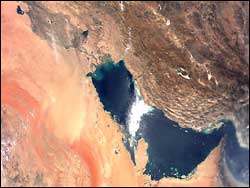Nanorobot fabrication makes ultrasmall sensors possible
How do you build an infrared (IR) camera that is small enough to fit on a mini-unmanned aerial vehicle (UAV) without cryogenic cooling? Call in the nanobots.
Researchers working with the Office of Naval Research (ONR) have developed a way to build extremely small sensors using nanorobot fabrication. This new process, created by Harold Szu and James Buss of ONR and implemented by Xi Ning of Michigan State University, a
Scientists at the Naval Research Laboratory’s Marine Meteorology Division in Monterey, CA, (NRL-Monterey), working with researchers from Monterey Bay Aquarium Research Institute and the National Geophysical Data Center, presented the first satellite detection of a phenomenon known as the “milky sea.” The satellite observations were corroborated by a ship-based account. This research was published in the October 4, 2005, issue of the Proceedings of the National Academy of Sciences (PNAS).
Rapidly fluctuating wind gusts blowing over mountains and hills can create “hotspots” high in the atmosphere and significantly affect regional air temperatures. A research paper to be published this month in the Journal of Geophysical Research-Space Physics reports that the actions of such winds can create high-frequency acoustic waves and could stimulate a 1000-Kelvin [1,000-degree Celsius; 2,000-degree Fahrenheit]spike in a short period of time in the thermosphere, at an altitude of 200-300 k
Something remarkable happened on the island closest to the epicenter of the great Sumatra-Andaman earthquake last December: Only seven of the island’s 78,000 inhabitants died. This is despite the fact tsunamis hit the island only eight minutes after the quake, despite the destruction of many Simuelue villages, and despite the lack of an official tsunami warning system and little in the way of telecommunications.
Why were the lives of Simuelue islanders spared when all around the I

A NASA study is offering new insight into how the Earth’s water cycle might be influenced by global change.
In recent years, scientists have warned that the water cycle may be affected by temperature changes, as warmer temperatures can increase the moisture-holding capacity of air.
The global water cycle involves the transfer of water molecules between the Earth’s land masses, cryosphere, oceans and atmosphere. It’s a gigantic system powered by the su
This Friday, scientists from ICES will release a report calling for a complete overhaul of deep-sea fisheries. Scientists will recommend that all existing deep-sea fisheries should be cutback to low levels until they can demonstrate that they are sustainable. They will advise zero catch of depleted deep-sea sharks, and they will recommend that no new fisheries for deep-sea fish should be allowed until it can be demonstrated that they are capable of being sustainable.
David Gri